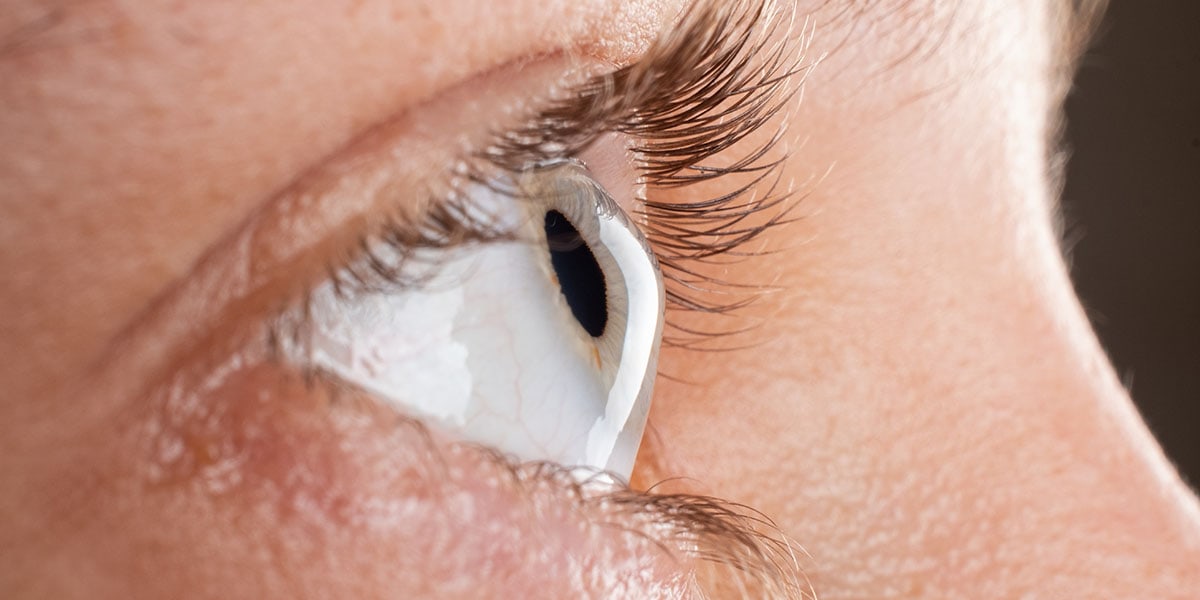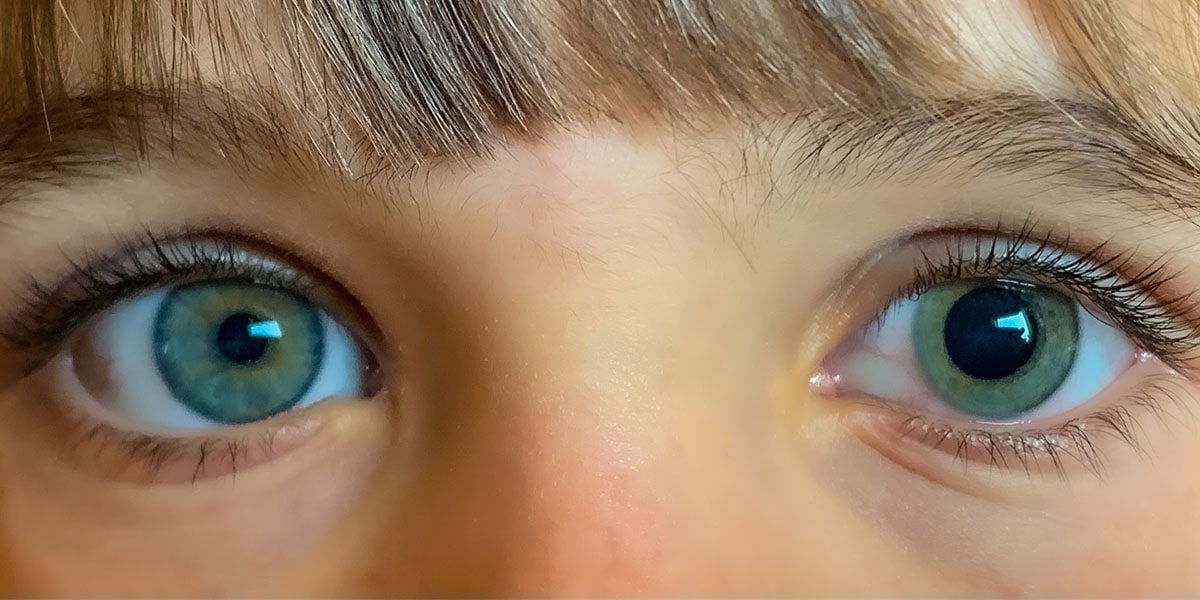- Home
- Patient Stories from Assil Gaur Eye Institute
- Light-Adjustable Lens Heals Jacqueline’s Cloudy Sight
Light-Adjustable Lens Heals Jacqueline’s Cloudy Sight

The first time Jacqueline Mayes experienced floaters in her left eye was almost 18 years ago after giving birth to her son, Tate. Eye floaters are spots in your vision that look like black or gray specks, strings, or cobwebs. They move when you move your eyes and move away when you try to look at them directly.
Over the years, the floaters came and went and were more of a nuisance than a medical emergency. But about a year and a half ago, Jacqueline, 57, says, they suddenly got worse. While on a herky-jerky ride at a local amusement park, rough movement caused a floater to appear with a vengeance. “A sheet of grey covered my eye, and I couldn’t make the floater move,” she says. “I couldn’t see as the grey fog blocked or smeared the image.”
Jacqueline works as a script continuity consultant in the film industry, providing detailed records of what’s been shot for each scene, plus information about wardrobe, props, set dressing, and hair. Her position requires ultra-keen eyesight to spot discrepancies on several small computer screens during shooting.
- "Take Me Out to the Ballgame" as Steve Can Now See Thanks to the Odyssey Lens!
- EagleVision® LASIK Gives Optometrist Crystal-Clear Active Life
- After Waiting 50 Years, Larry Gets Perfect Vision
- Ally Sheds Her Glasses After State-of-the-Art Odyssey Lens Replacement
- Light Adjustable Lens Gives Ellen Visual Clarity
- Light-Adjustable Lens Heals Jacqueline’s Cloudy Sight
- Actress Tiffany Smith Says Goodbye to Nearsightedness with LASIK
- Aram, a Civil Engineer is Back on Track with New Odyssey Cataract IOL Lens
- Cutting-edge Odyssey IOL lens lets Greta, a busy optometrist, toss her glasses aside
- EagleVision® LASIK Prepares Snowboarder for Olympics
- Eye Freckle Removal Surgery Worth a Cross-Continent Trip
- Sylvia says ‘lazy eye and cloudy vision be gone’ with Odyssey IOL replacement!
- Emily’s Urgent Retina Care Saves Her Eyesight
- Aaron travels from China for the ‘Magic of EagleVision' LASIK
- Nancy is glowing about her new PanOptix® IOL
- Perri, 39-year-old Cataract Patient, Finds Clear Vision 500 Miles from Home
- Dr. Richardson says AGEI stands at the top of eye surgery specialists
- Super lawyer Marc Katz enjoys life without glasses after enVista lens exchange
- Dan loves being glasses-free after Refractive Lens Exchange
- Merry Resolves Severe Ocular Complications with Perfect Monofocal IOL
- Steven Can Finally See His Own Reflection After RLE
- Janet, a Texas Teacher, Travels to Beverly Hills for Eye Freckle Removal
- It’s A Wonderful Life for Mike with 20/20 Vision and New Odyssey IOLs
- Kevin Says Eye Freckle Removal Surgery Was Well Worth the Wait
- Stacy Finds Second Eye Surgery’s the Charm thanks to AGEI
- Lucy’s Trip from Australia to Beverly Hills for Conjunctival Nevi Removal: A Worthwhile Journey
- With Her Cataracts Gone, Young Sara Sees like a Hawk!
- Adrenaline Junkie Finally Rides Safely Thanks to Odyssey IOL
- Julie After Her EagleVision LASIK Procedure
The road to an interocular lens and restored vision
A concerned Jacqueline quickly scheduled an appointment with her long-time optometrist. But after a cursory examination, the doctor told her it was nothing more than an ordinary floater. Nothing to be concerned about.
Convinced that her obscured sight was anything but “ordinary,” Jacqueline sat at her computer digging deeply into the internet, searching for the best doctors to treat floaters. Finally, Dr. Gaur of the Assil Gaur Eye Institute jumped out at her, having been named the best ophthalmologist in Los Angeles.
Using her functional right eye, Jacqueline eagerly read about the expertise of Dr. Pilyugina (or Dr. P, as her patients call her). The doctor received her ophthalmology training at Stanford University and completed a specialized two-year retina-vitreous surgical fellowship with the University of California at San Diego.
A consult visit was scheduled, but Dr. P was reticent to perform a vitrectomy (removal of the eye’s vitreous gel) because Jacqueline still had a natural eye lens. However, Dr. Kerry Assil agreed to perform a lens replacement, which would later be followed by the vitrectomy by Dr. P.
Because Jacqueline had a thin cornea, Dr. Assil recommended using a light-adjustable intraocular lens (IOL) — which is thinner and unlikely to cause damage to the cornea. This technique is commonly used in the treatment of cataracts, but in this instance was a necessary step in preparing Jacqueline’s eye for further treatment.
Types of IOLs
Depending on the patient’s sight in the affected eye, there are several IOLs to choose from. These include:
- Toric. Just like regular contact lenses, toric IOLs are meant to correct astigmatism.
- Silicon. The FDA has approved intraocular lenses made of silicone, which include a 3-piece silicone IOL and a 1-piece silicone IOL.
- Light adjustable lens. The eye doctor optimizes vision after lens implantation during a series of office-based light treatment procedures that take only a few minutes each.
How is IOL surgery performed?
Jacqueline’s outpatient procedure was done under local anesthesia. Dr. Assil created a tiny incision (so small it eliminated the need for stitches) and inserted the light-adjustable lens. The procedure took less than 30 minutes, and the recovery period was about two weeks.
After surgery, Jacqueline was told to avoid strenuous exercise or anything else that significantly increases blood pressure. She also needed to visit the ophthalmologist regularly for several months to monitor the implants.
About the light adjustable lens
The adjustable light lens is a special IOL that allows the level of correction to be decided after surgery. The light-adjustable lens is fine-tuned using ultraviolet light in a medical office.
When you have cataract surgery, the clouded lens is removed and replaced with a new, artificial lens. While Jacqueline didn’t have cataracts, her light-adjustable IOL procedure followed the same process.
Customizing the lens
After an uneventful surgery, Jacqueline was given two pairs of protective glasses — one with clear lenses, one with brown lenses — to keep out ultraviolet rays. She wore them every minute unless bathing or sleeping. During the recovery process, she also had eye drops that needed to be applied daily to assist in healing.
“They aren’t a terrific fashion statement, but they were comfortable,” she says, adding that ultraviolet rays could skew her new lens.
The doctor provided Jacqueline with several visual options to find the best prescription lens for her. After narrowing it down and finding the one that provided the most precise vision, she began her light treatments. The doctor used a Light Delivery Device (LDD) to adjust the lens to fit Jacqueline’s prescription.
Jacqueline underwent three 90-second light treatments. Between the treatments, she continued to wear her protective glasses.
After three light treatments, Jacqueline was ready to see the world. “End of story, my vision is crystal clear in my left eye,” marvels Jacqueline. “It was a life-changing event.”
There’s no need for further surgery or any other form of invasive treatment.
On with the show
Though she still spends plenty of time with her son, who’s going off to college in the fall, Jacqueline is back on the set. Specializing in filming advertisements, you may have seen her work on MTV and ADT commercials.
Though she still wears reading and distance glasses for driving, Jacqueline has 20/20 vision.
“I have awesome vision, and the end result was worth every second of the work,” says a satisfied Jacqueline.
Why trust your eyesight to Assil Gaur Eye Institute?
Under Dr. Assil’s leadership, the Assil Gaur Eye Institute has assembled a team of top ophthalmology specialists from around the country who continue AGEI’s tradition of offering patients the highest quality of specialist eye care in the United States. In keeping with the founding principles of AGEI, our doctors have managed to keep their clinics comfortable and familiar, much like how family-run medical practices used to be.
Today, the Assil Gaur Eye Institute is nationally recognized for its compassionate patient-centric care, its commitment to pioneering advances in ophthalmology, and its dedication to supporting the health and well-being of its patients and community.
Please call (866) 945-2745 or make an appointment online.
We are conveniently located for patients throughout Southern California and the Los Angeles area at locations in or near Beverly Hills, Santa Monica, West Los Angeles, West Hollywood, Culver City, Hollywood, Venice, Marina del Rey, Malibu, Manhattan Beach, and Downtown Los Angeles.














